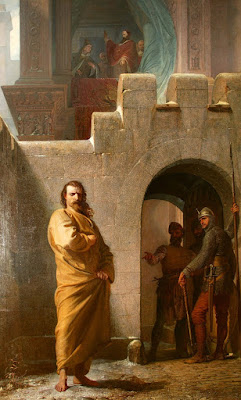 |
| Henry at Canossa |
Medieval Europe saw two powers
that dominate the continent. – the Pope and the Holy Roman Emperor. The Pope
was the head of the Catholic Church. Situated in Vatican City, he rule the
whole church with his power derived from St. Peter. The Holy Roman Emperor was
the ruler of a federation of princely and free city states at the heart of
Europe. It derived its power from the anointment of God and the first Holy
Roman Emperor, Charlemagne.
And so the battle over Lay
Investiture began in 1075. In March of 1075, Pope Gregory VII released the Dictatus Papae that laid out the powers
of the Pope in a 27 statements. Among the statements, the Pope clarified that
he was the higher power than the Holy Roman Emperor. Following the 27
statements, Pope Gregory followed up by banning lay investiture. The Holy Roman
Emperor, Henry VI, was furious about the actions of the Pope. In retaliation,
he convened all the bishops he had appointed previously to the city of Worms in
January of 1076. The result of the meeting in Worms called for the removal of
the Pope. Henry accused the Pope of taking the highest Pope in the church by
not being elected in a conclave, violating the rights of Princes and nobles to
lay investiture, and the seducing of an Italian noblewoman named Mathilda.
Outraged, Pope Gregory
escalated the tensions by excommunicating Henry IV on February 22, 1076. Excommunication meant that Henry could no
longer receive the sacraments. A stigma was attach to individuals declared excommunicated
by the Pope. With the excommunication from the Pope, Henry’s support based
shrank. Bishops he appointed and nobles all began to withdrew support for him. In
addition, Pope Gregory supported the revolt of Saxony against Henry.
With his position as Holy
Roman Emperor threatened by his excommunication, Henry was forced to make peace
with the Pope. On wintery January of 1077, Emperor Henry IV, along with his
wife Bertha and son Conrad, walked across the Alps. Their destination was the
Italian town of Canossa where a castle hosted Pope Gregory IV. Upon his
arrival, Henry showed a humble appearance, wearing simple clothes. He waited at
the gates of the castle. Pope Gregory VII, on the other hand, wanted to teach
the Emperor a lesson and degrade his status. For three days, the Pope made
Henry wait in the gates under the strong winter winds and snow. Henry endured
the three days without any complains. Inside the castle, servants were begging
the Pope to forgive and allow the Emperor into the castle. The Pope was
obligated to forgive those who repented to their sins, he just wanted to embarrass
the Emperor. And so, after the three day stand-off, the Pope allowed the entry
of Henry and removed the order of excommunication. In exchange, however, Henry
would drop the power of lay investiture. After the removal of excommunication,
a banquet was held to celebrate the reconciliation between the two.
The so-called “Humiliation
in Canossa,” however, changed little. Although Henry dropped claims over lay
investiture, the issue did not saw a final conclusion in Canossa. Also, it did
not signal the start of a brand new good relationship between Henry IV and Pope
VII. Gregory VII, years later, excommunicated Henry IV once again after the
Pope supported the removal of the Holy Roman Emperor and replacing him with the
Duke of Saxony. Nevertheless, the Humiliation in Canossa display the formidable
power and influence of the Pope during the Medieval Ages. An Emperor that
commanded armies and great lands was made to wait outside a castle, under very
cold conditions, by a man serving as successor of St. Peter.
See also:
April Fools' and Gregorian Calendar
How a Pope Spread Coffee?
Bibliography:
Bauer, S. The History of the Medieval World: From Conversion of Constantine to the First Crusade. New York: W. W. Norton , 2010.
Beck, R. et. al. World History: Patterns of Interaction. Florida: Houghton Mifflin Harcourt Pub. Co., 2012.
See also:
April Fools' and Gregorian Calendar
How a Pope Spread Coffee?
Bibliography:
Bauer, S. The History of the Medieval World: From Conversion of Constantine to the First Crusade. New York: W. W. Norton , 2010.
Beck, R. et. al. World History: Patterns of Interaction. Florida: Houghton Mifflin Harcourt Pub. Co., 2012.


.jpg)


No comments:
Post a Comment
Note: Only a member of this blog may post a comment.